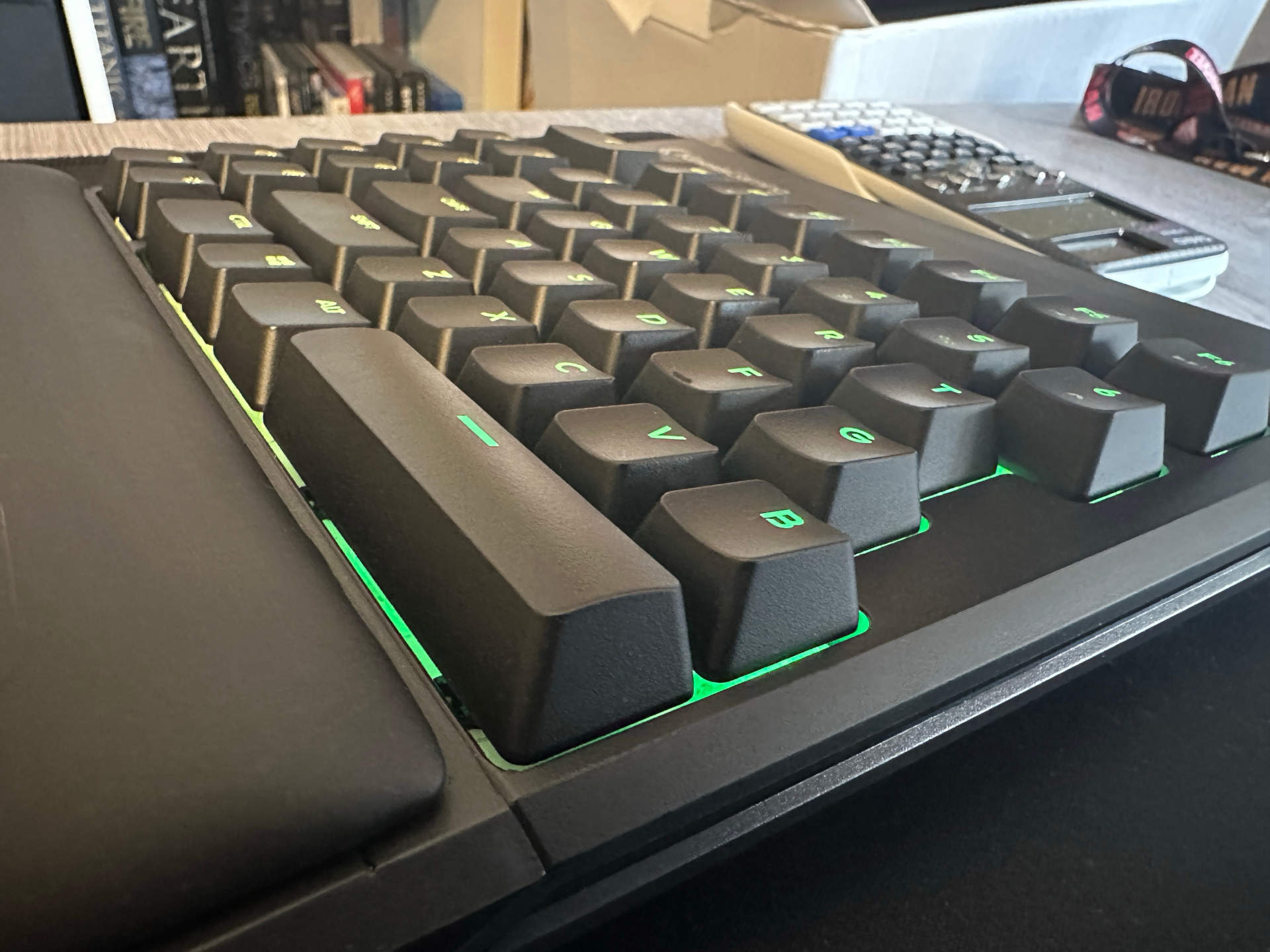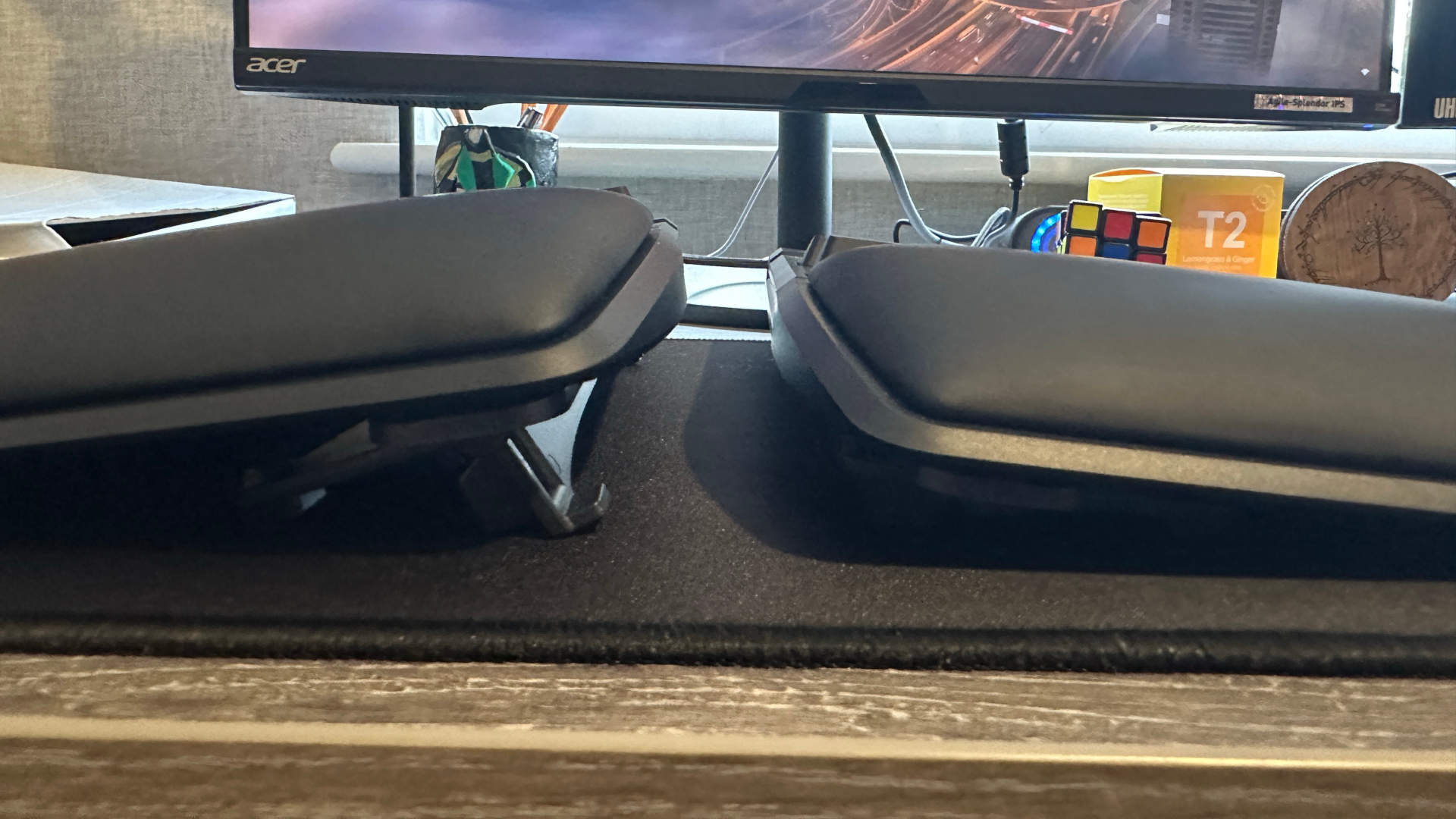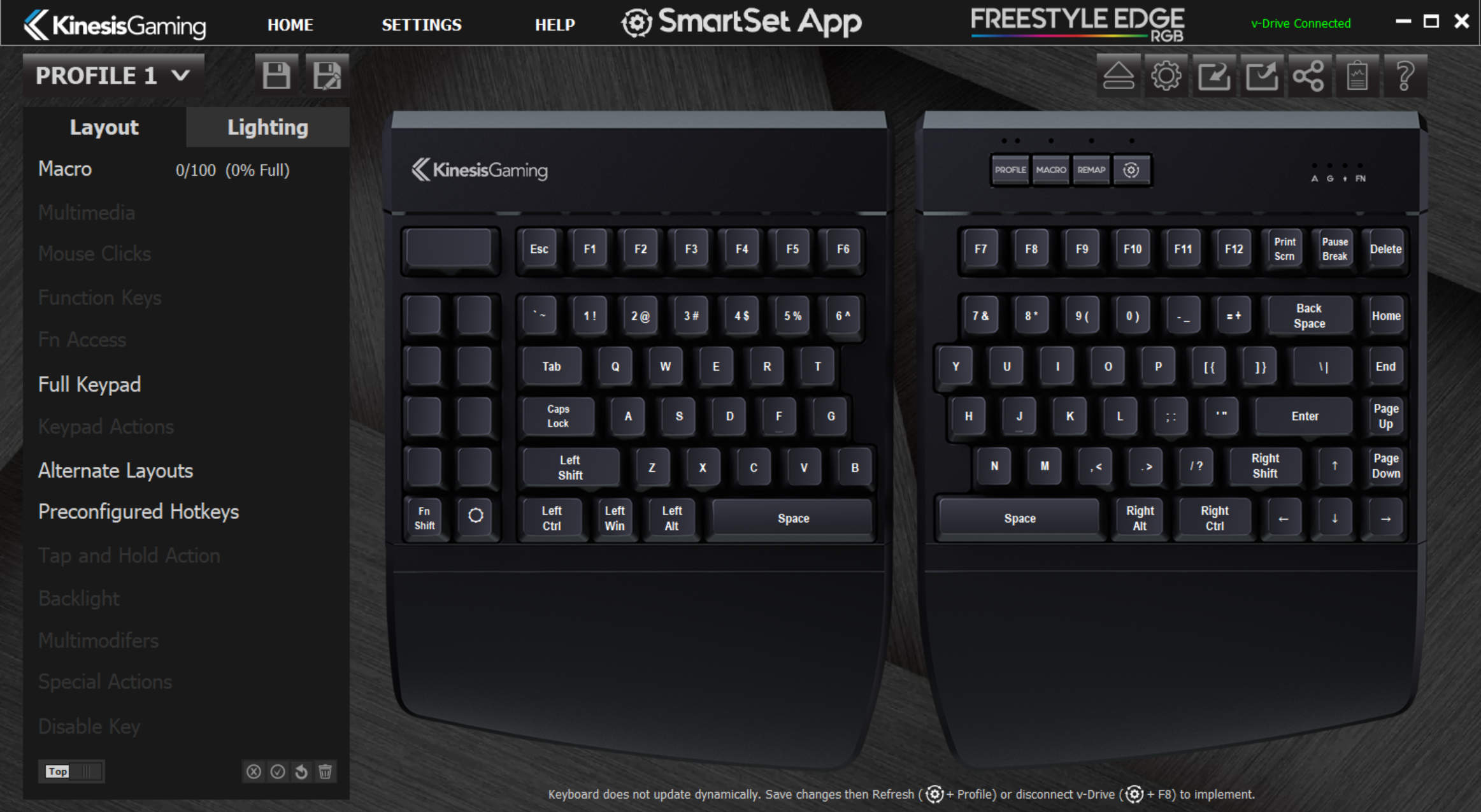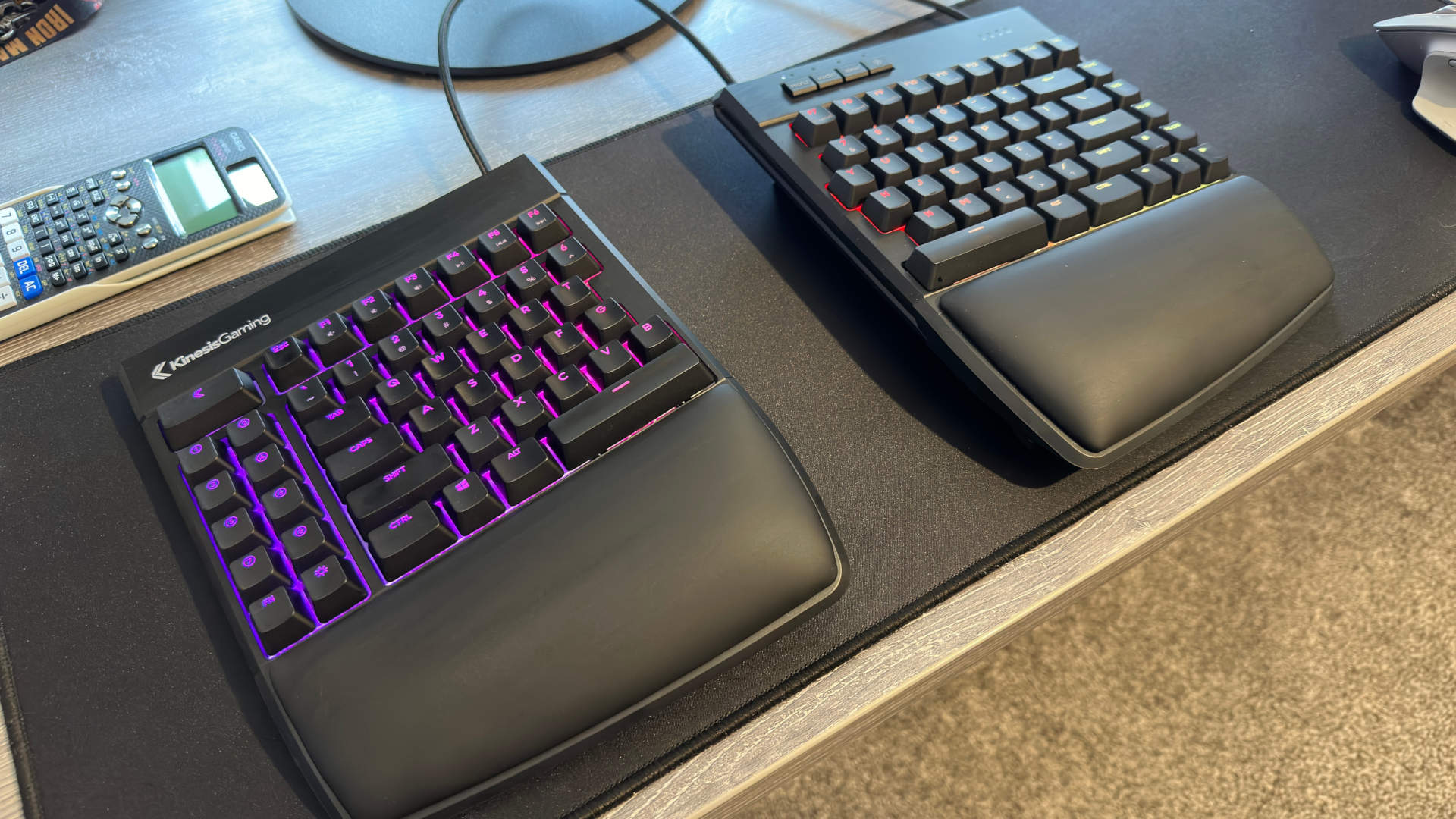Our Verdict
The best ergonomic keyboard for PC gamers right now, thanks to its sheer comfort and usability, though it's a shame the lift kit isn't included.
For
- Super comfortable to use
- Fast and feature-packed
- Lots of macro keys
- Great for smaller hands
Against
- Fixed cables are pretty stiff
- Lift kit is an optional extra
- Expensive, even for an ergo keeb
PC Gamer's got your back
22 January 2024: Further details on the operation of the v-Drive have been added to the review, with thanks to Kinesis for clarifying the design.
Kinesis is a Seattle-based firm that's been designing and manufacturing ergonomic keyboards for over 30 years. Recognising the fact that it's not just professionals who need peripherals that reduce stress on hands, wrists, and shoulders, it created the Kinesis Gaming division in 2016, with models aimed specifically for the PC gaming crowd.
It only offers a small line up of three models, but the Freestyle Edge RGB that I've been testing is definitely the star of the show. It's a fully split design, with the two halves permanently connected via a cable, and it connects to any PC, Mac, or Chromebook via a long USB Type-A wire. I would have preferred them to be detachable cables, for ease of transport.
There's no shortage of cable length, though, with the inner one offering up to six inches of spacing and the main cable being 20 inches in length. In the case of the former, any excess can be tucked away inside the chassis, but I found the braided cables to be pretty stiff. You'll be able get each section into the perfect position for your shoulders, but might find that the cables tend to get in the way of things on your desk, as I did.
I don't have especially large hands and found the Freestyle Edge RGB's somewhat compact layout suited me perfectly; at no point did it ever feel like a stretch to reach any of the usual keys.
It comes with a set of supremely well cushioned wrist rests and if they're not to your liking, they're easily detachable. What is rather surprising, though, is that the keyboard doesn't come with any tenting or tilting ability. Not directly so, at least.

Switches: Cherry MX Red/Brown/Blue/Speed Silver
Connectivity: wired (USB Type-A)
Keys: 95 in total
Split: fully separate halves
Tenting: none, optional kit (5/10/15 degrees)
Tilting: none
Backlighting: per-key RGB
Media controls: programmable shortcut keys
Price: $199/£230/€238/AU$371
Tenting essentially means having the inner part of the keyboard raised and it helps prevent your wrists from being unnaturally rotated. For me, tenting is a must for any keyboard that I use, thanks to wrist injuries I sustained many years ago.
Kinesis Gaming does offer a lift kit for the Freestyle Edge, though. At face value, it just looks like a couple of pieces of flimsy plastic but once clicked into place, they're rock solid. With them, you can select between five, 10, and 15 degrees of tenting, and I found 10 to be the most comfortable. The lift kit sells for just under $30 in Kinesis' store, which is a bit on the pricey side for what they are.
To be honest, if you're spending two hundred dollars on a keyboard, you'd expect a few extra bits of plastic would be included in the box.
There's no tilting option, unfortunately, so if you prefer to use a standing desk, then you might find the lack of this to be a tad annoying. Having said that, it is aimed at gaming, and how many of us rock a few rounds of CS:GO while standing?
The Freestyle Edge is a fully mechanical keyboard, and you have the option to select one of four Cherry MX key sets, when you place your order. My review sample came with Browns, which are low force and near silent (and just my cup of tea). Alternatives include Reds, which are similar to Browns but with a more linear feel to them, as well as fast Speed Silvers or classically clacky Blues.
I found it an absolute joy to type on. Not just because it suited the size of my hands really well but because every key worked exactly as expected, with the feel being consistent across the whole board. Normally it takes a while to adapt to a new keyboard but I hit my usual speed within a day.
There are eight additional keys that can be programmed for single use or specific macros, all of which is handled via the SmartSet app (more on that later). As per its name, there's fully adjustable per-key RGB backlighting, with a dedicated key to disable it. The LEDs are bright and vivid, so if you fancy a small disco in your gaming room, fire up this keyboard for some dance action.





Tucked away at the top of the right half are four buttons that have specific functions, letting you switch between nine different profiles, recording macros, and remapping the keys.
The last of these is called the SmartSet button and using this in junction with some of the number keys, fires up some additional modes. One of them is Game Mode, which disables the Windows key, to prevent you from firing up the Start Menu mid-game. Another actives NKRO mode, which lets the keyboard register all simultaneous key presses.
Normally this is limited to around six but if you want the absolute maximum key response across the whole board, for frantic games, then this button is just for you. I personally never needed to switch it on but I'm ancient and very slow, and found the regular mode to be perfectly fine.
✅ You want the best ergo+gaming experience: You'll need the optional lift kit, of course, but with it you'll have the perfect blend of comfort, speed, and gaming features.
❌ You're on a tight budget: The base price is pretty high, even for an ergonomic keyboard, and you really need the optional $30 lift kit to get the best comfort in use.
While the Freestyle Edge RGB can be programmed in situ, you'll find it all a lot easier to do via the SmartSet app. The first big plus I noticed is that there are versions for Windows and MacOS, plus the source code for it is available on Github, allowing you to compile it for the operating system of your choice.
It's pretty basic looking but quite easy to use, more so if you read the manual and follow all its instructions. Which I didn't, of course.
The first thing that stumped me was the program just didn't recognise the fact that I had the keyboard plugged in. Cue half an hour of me messing about, trying different USB ports, PC reboots, and head scratching galore. All that would have been avoided had I just bothered to look up what to do in the first place.
To change anything via the app, you first need to enable the 'v-Drive' by pressing the SmartSet key + F8. Doing this then opens up the onboard memory as a tiny USB memory stick from the perspective of the operating system, and once done you can play with things to your heart's content.
After you've done all the changes required, you eject the v-Drive as you would with any removable USB device. It's a little puzzling as to why Kinesis designed it to work in this manner, as I've yet to come across a programmable keyboard that puts such a barrier in the way.
At least it does prevent anyone else from messing up your settings but since you can program the keyboard without the use of the app anyway, it does seem like an unnecessary step.
It turns out that there is a good reason for this design choice: The app is nothing more than an interface for updating a text file on the v-Drive. By using this simple method, it will work on pretty much any operating system, and no special drivers or clever software routines are required.



It's probably the closest to perfection that I've experienced in a gaming-orientated ergonomic keyboard
But it's a minor issue in the grand scheme of things and I found that to be true of all the aspects that I didn't particularly like, such as the stiff, hard-wired cables, and the lack of tilting. None of these were deal breakers for me and the sheer pleasure of using the Freestyle Edge RGB just pushed them into the background.
It's probably the closest to perfection that I've experienced in a gaming-orientated ergonomic keyboard, being extremely comfortable in use and a joy to type and game on. Would I buy one myself? Absolutely, though perhaps with one reservation.
It's not remotely cheap and I don't mean that in the sense that it feels like a supremely high-quality piece of kit, as it feels just like any other well-made keyboard. The baulking point for many people will be the price: The standard cost for the Freestyle Edge RGB in the Kinesis Gaming store is $219 and it's currently on sale at $199, but that's still a lot of money to spend on a keyboard.
As Kinesis is a US-based firm, buying it elsewhere in the world bumps the price up even more. For UK shoppers, it's £230 at Amazon, around €238 in the EU, and Australian gamers will need to fork out $371. Shipping is oh-so painful at times.
Then, there's the fact that you really do need the lift kit for the full ergo experience, which is an additional $30. If you don't require tenting, then obviously you can save that bit of cash, but then there are cheaper split keyboards on the market.
However, the overall product is superb, despite the combined $229 price tag. Yes, you're paying a pretty penny for such excellence but it's not hard to see why Kinesis has been around for so long when it's making ergonomic keyboards this good.
The best ergonomic keyboard for PC gamers right now, thanks to its sheer comfort and usability, though it's a shame the lift kit isn't included.

Nick, gaming, and computers all first met in 1981, with the love affair starting on a Sinclair ZX81 in kit form and a book on ZX Basic. He ended up becoming a physics and IT teacher, but by the late 1990s decided it was time to cut his teeth writing for a long defunct UK tech site. He went on to do the same at Madonion, helping to write the help files for 3DMark and PCMark. After a short stint working at Beyond3D.com, Nick joined Futuremark (MadOnion rebranded) full-time, as editor-in-chief for its gaming and hardware section, YouGamers. After the site shutdown, he became an engineering and computing lecturer for many years, but missed the writing bug. Cue four years at TechSpot.com and over 100 long articles on anything and everything. He freely admits to being far too obsessed with GPUs and open world grindy RPGs, but who isn't these days?


